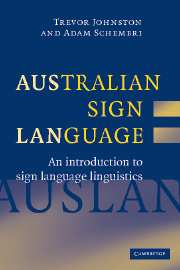Book contents
- Frontmatter
- Contents
- Acknowledgements
- Conventions for sign notation
- 1 Signed languages and linguistics
- 2 Auslan in social context
- 3 Auslan and other signed languages
- 4 Phonetics and phonology: the building blocks of signs
- 5 Morphology: sign formation and modification
- 6 Lexicon: the structure of Auslan vocabulary
- 7 Syntax: the structure of sentences in Auslan
- 8 Semantics and pragmatics: sign meaning and sentence meaning
- 9 Discourse: structure and use above the sentence
- 10 Issues in the study of signed languages
- References
- Index
8 - Semantics and pragmatics: sign meaning and sentence meaning
Published online by Cambridge University Press: 02 December 2009
- Frontmatter
- Contents
- Acknowledgements
- Conventions for sign notation
- 1 Signed languages and linguistics
- 2 Auslan in social context
- 3 Auslan and other signed languages
- 4 Phonetics and phonology: the building blocks of signs
- 5 Morphology: sign formation and modification
- 6 Lexicon: the structure of Auslan vocabulary
- 7 Syntax: the structure of sentences in Auslan
- 8 Semantics and pragmatics: sign meaning and sentence meaning
- 9 Discourse: structure and use above the sentence
- 10 Issues in the study of signed languages
- References
- Index
Summary
Semantics refers to the study of meaning in language (i.e., how words and sentences are used to convey particular meanings). But what is ‘meaning’? How do we understand what the signs and sentences used in Auslan or other languages actually mean? Although most people may not be confused about what the word meaning refers to, providing a clear explanation of how language structure makes meaning is not an easy task. In fact, philosophers dating back to Aristotle and Plato have pondered the relationship between language, meaning and the world, and it is still an area in which there is much debate and diversity of ideas (Saeed, 1997). Understanding how language creates meaning is a highly complex task, because it needs to take into account all the different ways language structure is used to convey information. We shall look at some of the ways signed languages do this in this chapter, but we will begin by examining some of the misconceptions around the concept of meaning in language. We will then examine different types of meaning in Auslan signs, before moving on to look at iconicity. This is followed by a discussion of sentence meaning, and the chapter ends with an exploration of pragmatics (i.e., the study of meaning and context).
Auslan signs, English words and meaning
One very common misconception about the semantics of Auslan stems from a misunderstanding of the relationship between English and Auslan. We have already discussed this issue in some detail in Chapter 1, but we will revisit it briefly here.
- Type
- Chapter
- Information
- Australian Sign Language (Auslan)An introduction to sign language linguistics, pp. 219 - 252Publisher: Cambridge University PressPrint publication year: 2007

